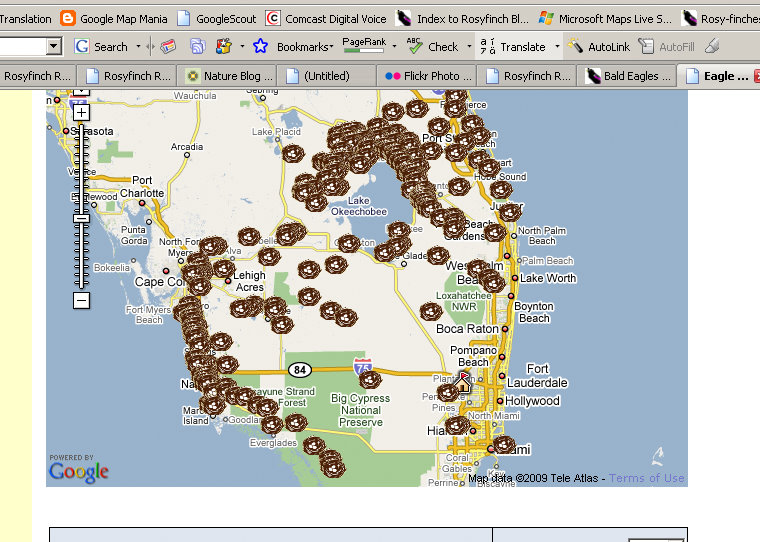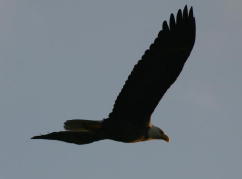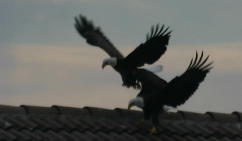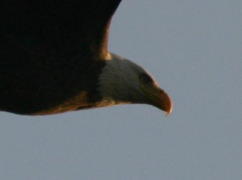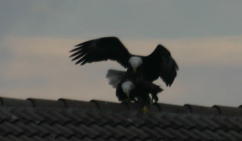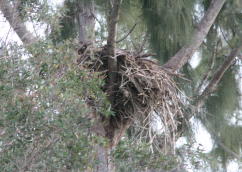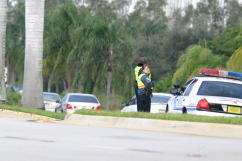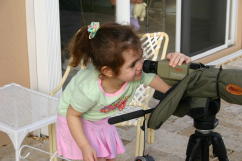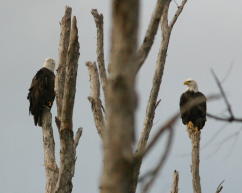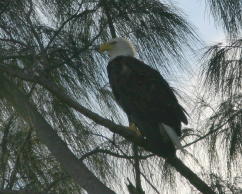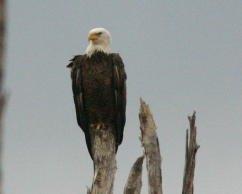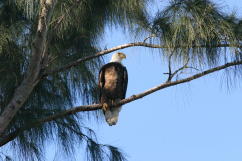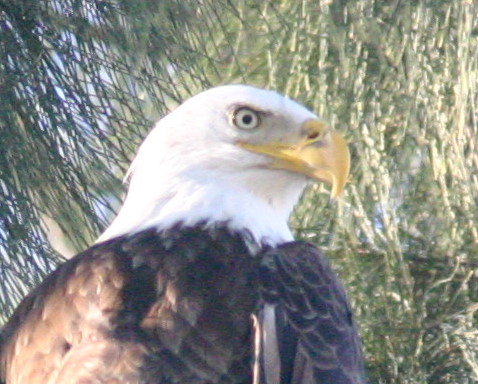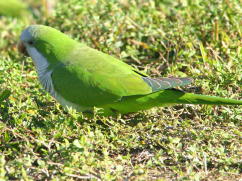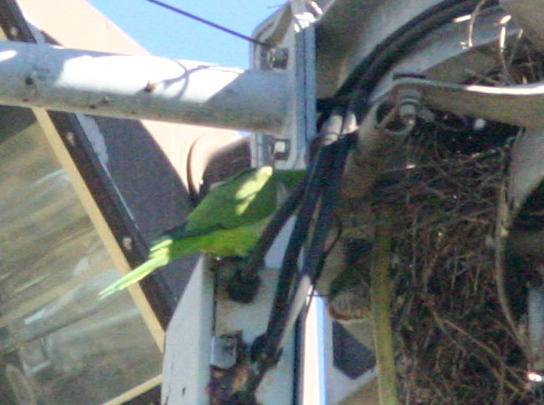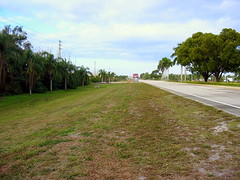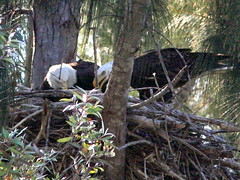The "Donut Hole" in FWC
Bald Eagle Permitting Process
(Some
reflections)
The
Florida Fish and Wildlife Conservation Commission (FWC is) limited by
law and guidelines as to the amount of authority it may exert in this
case. In effect, their only available remedy is to advise Broward
School Board that they are prohibited from undertaking
any construction activity within 330 feet of the nest while eaglets are
present. Indeed, FWC personnel are now in contact with the Board and
its contractor and
are providing advice and assistance. Ironically, if the
activity
were to be carried out 330 to 660 feet from the nest, the School Board
would
have had the option to apply for a voluntary permit, which would give
FWC added leverage to formally monitor and suggest modifications to the
activity so to minimize disturbance and the possibility of a
“take” that would have serious consequences.
The FWC Bald Eagle protection efforts are limited by the absolute
prohibition against any disturbance within the 330 foot perimeter,
until the eaglets have fledged. This regulatory "donut hole" occurs, as
in the case of our local nest, even though there are already myriad
disturbances within the 330 foot nest perimeter. This gap is
illustrated in the Eagle Management Plan permitting process flowchart.
The FWC Bald Eagle Management Plan incorporates the National Bald Eagle
Management Guidelines (USFWS 2007b), which, to reduce the potential for
human activities to adversely affect nesting bald eagles, recommend
“the establishment of a single buffer zone 660 feet or less
from
the nest, depending on the presence or absence of existing activities
(of “similar scope”) and the visibility of the
activity
from the nest.”
According to the FWC management plan, “an existing activity
near
a bald eagle nest is of similar scope to a proposed activity, when the
project is similar in nature, size, and use.” If eagles are
already tolerating activities that are similar in scope to the proposed
construction, there is, theoretically, less potential for the new
activity to cause abandonment of the nest. This could be a very useful
concept, but unfortunately, it may not be applied if the activity is
nearer than 330 feet. Any activity that is closer to the nest than
existing tolerated activity "of a similar scope" should be delayed
until after the nesting season.
In cities and suburbs, such disturbances should be expected with great
frequency, and with varying degrees of urgency. Utility lines are
repaired and replaced, roads are resurfaced, signs and traffic controls
are installed and serviced, and vegetation and shrubs are regularly
trimmed with mechanized equipment. Imperfect as our knowledge of the
behavior of newly urbanized eagles may be, it would appear prudent for
FWC to be empowered to take a more formal role in guiding and
monitoring construction within the urban “donut
hole,” just
as it does in the 330-660 foot zone.
As
eagles seek and increasingly find more urban nesting locations, FWC
needs more leverage to either negotiate and issue modified permits, or
better enforce the existing protection of the nest from disturbances
that it judges to be nearer and/or greater in scope than existing
disturbances.
If
a negotiated FWC permit were required under such special circumstances,
FWC personnel would have greater authority to require measures to
protect the eagles (and provide a measure of liability protection for
contractors) by inserting conditions that are specific to the situation
in the field.
For
example, such a special permit could take into consideration the
applicant's use of alternative technologies and procedures that serve
the same purpose, but cause less disturbance than traditional methods.
Such conditions, now negotiated informally, would thus be formalized in
the special permit, FWC would have more authority to enforce the
agreed-upon measures.
Such an approach would be educational rather than punitive, but backed
by the negotiated special permit. The only trigger for enforcement
should not be the death of a chick, or abandonment of the nest, which
is a worst-case scenario.
These guidelines are remarkably impotent as a means of regulating the
protection of Bald Eagles. Note that Eagle permit is never
"required," it is always voluntary. And anyone may proceed based upon
their own interpretation of the rules, and not face a penalty unless
they "take" an eagle and are caught and prosecuted. ("Take" includes:
pursue, shoot, shoot at, poison, wound, kill, capture, trap, collect,
molest or disturb). |
|
Responsible
Agency is Broward County School District; FWC Provides Advice
(This page may be updated
frequently; please refresh your browser for latest content)
We have learned from Scott Brunner, P.E., the Broward County Signal
Operations Engineer, that the signal at Pines Boulevard at 209th Avenue
is not being installed by Broward County Traffic Engineering, but by
the Broward County School District and their consultants/contractors
through a Florida Department of Transportation (FDOT) permit.
Based
on the advice he received from FWC, Mr. Brunner notified the FDOT as
well as the contractor, strongly encouraging "all project managers
associated with this project to coordinate with the FWC to minimize any
impact to this protected species." Mr. Brunner also said:"The poles
will be installed using large augers rather than pounding any type of
poles into the ground... the signal construction should be in the
450’-800’ range of the nest."
Mr.
Brunner also forwarded, to FDOT and the contractor, advice provided
last week to the County Traffic Engineering Division by Sharyn Hood of
FWC, who provided links to information on regulations and guidelines,
stating: "Apparently this is the first eagle nest in Broward County
since the 1970s, so the nearby residents are very excited about the
nest and understandably protective."
On
the assumption that the work would involve trenching along the roadside
in front of the eagle nest, Ms. Hood stated (January 22, 2009):
"As
I understand now, work nearest to the eagle nest would involve
trenching along the roadside; while I am not familiar with the type of
machinery needed to accomplish this work, I can assume it would be
larger and noisier than the disturbance currently caused by normal
traffic in the area. Based on this, FWC would not recommend
moving forward with work until after the chick(s) have fledged from the
nest. Doing so would put Traffic Engineering (or contractors
–
whomever is responsible for the project) at risk for a potential
violation of FWC’s eagle rule, which prohibits take (harass,
harm, disturb, cause nest abandonment or failure).
"Our
agency does offer disturbance permits for work that will take place
during the nesting season and between 330’ and 660’
of an
active nest if our guidelines cannot be followed. We do not, however,
issue permits for work done within the 330’ buffer of an
active
nest during the nesting season, and so would not issue a permit for
this particular project. The county can choose to proceed with the
work, but takes a risk of causing take and being cited for a violation
(if the nest fails due to excessive disturbance, the birds abandon,
etc.). Outside the nesting season (Oct 1 – May 15,
or
whenever eagles are present at the nest site), temporary activities
(which this would likely be considered) can proceed without an FWC
permit. Local nest-watchers have indicated that at least one
chick hatched on or near the weekend of Jan 17-18, and assuming around
11 weeks until the chick(s) are able to fly means that they should be
flying around the end of April.
"One
option is to postpone work in this area until the chick(s) are capable
of sustained flight, after which work could proceed inside that
330’ buffer without much concern. The other is to
move
forward with the work and take a chance with disturbance and/or nest
failure or abandonment. If you have a need to move forward at
this time, I would strongly recommend postponing work for at least a
few days until the weather has warmed up – this way if the
adults
are disturbed from the nest for a period of time the risk of exposure
for the chicks will be lessened. Another recommendation might
be
to use smaller machinery or even do some of the digging manually (if
feasible) in areas closest to the nest to reduce disturbance.
"I
hope the information is helpful to you in making decisions about this
project. Please let me know what other assistance I can
provide,
and thank you again for your time and concern. I would
appreciate
an update as you proceed with your discussions, and will be happy to
try and answer any questions you might have."
UPDATE:
Mr. Brunner has provided additional information about the routing of
the line to the traffic signal.Eagle nest watchers were concerned
because we assumed that excavation would occur in front of the nest.
The scenario may not involve any excavation within 450 feet of the
nest. Mr. Brunner promised to keep us advised as he learns more about
the specific plans. This is very reassuring news! He provides an instructive map
and writes (January
26, 2009):
"The
current plan calls for a new electric power service point originating
from an FPL pole west/northwest of the eagle nest (southeast from the
intersection). It is possible that the work we saw being
performed near the FPL pole previously was related to providing future
service points for 120 volt service, such as for this traffic signal --
however I do not have confirmation of this at this time. The
actual service connection for the traffic signal would require very
minor excavation (hand dig) for a pull box at the base of the FPL pole,
and a vertical rigid conduit connection up the pole -- no major
excavation. Underground conduit will have to be directional
bored
from the intersection to the pullbox at the base of the FPL pole, but
the directional bore machine can be set up at the intersection 450+
away. It is somewhat noisy, but probably not noticeable relative to
ambient traffic on Pines Blvd if it is set-up close to the roadway.
"Another
option would be to establish a new service point connection at the FPL
pole west/southwest of the intersection, further away west of the nest.
If the service point has not already been established by FPL at the FPL
pole southeast of the intersection (described above), then going to the
southwest pole would be advisable. If there is already an FPL
service point at the southeast FPL pole, then it actually may be less
intrusive to proceed with using that pole. I will pass this
info
on to the School District's signal design engineer. "
We
believe that criteria for the need of a FWC Eagle Permit permit
now appear to be met, because the major construction will
actually
take place just outside the 330 foot limit. We wonder whether the
School Board will apply for a permit, or elect to proceed without one.
So far, FWC has informed us that the agency has been in contact with
the School Board and also with the contractor that will be installing
the signal. No decisions have been made about a permit (it is
not
yet clear whether FWC will recommend a permit) or the details of the
construction schedule. FWC personnel will be meeting with
them
soon to discuss the details of the project and anticipated construction
activities, and will keep us informed as to the outcome of these
discussions, and any decisions that may be made.
Excavation will be required in front of nest
February 4, 2009:
We have learned that the installation of the signal at 209th Street and
Pines Boulevard by Broward School Board will require a communication
line to be run from 209th to 208th on the south side of Pines, passing
about 190 feet in front of the Bald Eagle nest tree. This will require
excavation of a trench that will be only about 18 inches deep. Such
trenching does not require a backhoe, so it may be possible for the
contractor to complete the trench relatively rapidly and with lighter
machinery and less disturbance. However, for some reason, the concrete
box that is only about 215 feet from the nest must be relocated several
yards to the east. Digging up the box and excavating at its new
location may require heavier equipment.
We urge that such work not be conducted during cold or rainy weather,
and that consideration be given to staging the work so that there are
not prolonged periods of disturbance on any one day. Alternatively, the
School Board might reconsider the need to relocate the box. This
would minimize the duration of any temporary avoidance of the nest site
by the adults and possibly reduce the risk of abandonment. The
contractor will be meeting with FWC officials tomorrow in an effort to
reach some agreement on timing of the installation, or, if the traffic
signal must be installed before the eaglets fledge, to decide upon
construction approaches that create the least disturbance.
As I looked at the nest area today, it appears clear that some of the
Australian Pines that are near the FPL transmission lines will need to
be topped or trimmed before hurricane season. There should be ample
time to take care of this after the breeding season. I will investigate
this issue, to assure that FPL or any other public utility that may use
the poles are aware of the existence of the nest and the need to
protect the birds while chicks are in the nest.
UPDATE: February 9, 2009:
FWS has not yet provided a status report on the results of their
meeting with the Broward County School Board officials responsible for
scheduling the construction. As mentioned, they have provided good
advice to the contractor. We will let you know
as soon as we learn whether the School Board decides whether to delay
the project until the eaglets leave the nest tree.
Lynda White, Eagle Watch Coordinator at the Audubon Center for Birds of
Prey in Maitland, Florida provided us with some reassurance about the
risk of nest abandonment, stating that there would be greatest
concern about disturbances in late March and early April, when the
eagles may be out on the branches of the tree but not yet fully capable
of free flight.
She says, "Once the adults have eaglets they are more invested in the
nest and much less likely to abandon. The most vulnerable time for them
is early in the season, before or just after eggs are laid. Even if
they are startled off the nest, they won't go far and will return
within a short time to care for the eaglets. I would be more concerned
if the eaglets were at the fledging stage, for they might jump, but
these youngsters are too small to be concerned with any disturbance.
Also please remember that eagles are far more likely to be disturbed by
humans on foot than vehicles. Too many people in their line of sight
will cause more stress than construction activity a few hundred feet
away. The number of onlookers needs to be kept to a minimum, including
children running around."
We have noted that the eagles often stare quite intently at us as we
observe them on the nest or roosting nearby. Yesterday, even the chick
appeared to scrutinize the photographers and other onlookers. These
birds have, at least twice, successfully hatched out their eggs despite
traffic noise (including the sirens of emergency vehicles, which they
seemed to ignore). The students of the seventh grade science
class are documenting the birds' behavior during times of varying
traffic density, and hope to add to our knowledge of how these normally
shy birds adapt to city life.
Broward County School Board Suspends Construction Until Eagle Chicks Leave Nest
BULLETIN: February 10, 2009-- Sharyn Hood, Assistant Regional Biologist
in the Division of Habitat and Species Conservation, Florida Fish
and Wildlife Conservation Commission South Regional Office in West Palm
Beach, has provided good news about protection of the eagle nest.
Sharyn also provides a caution to eagle watchers. She writes:
"I think things have finally been worked out with all parties.
Because construction can’t be completed without working within
the 330’ buffer zone, FWC has recommended that the project, or at
least the work within 330’, be postponed until the eagle
chicks have fledged. The Environmental Department representative
from the school board fully supports this recommendation, so it looks
like things will be delayed until sometime in April. FWC can
allow work to proceed between 330’ and 660’ without
recommending a permit if the US Fish and Wildlife Service’s Nest
Monitoring Guidelines are followed, but it’s my understanding
right now that the school board is not in a position to be able to
provide that monitoring; that’s why they are also suggesting
delay of the construction. Everyone I’ve spoken with is
fully committed to doing what’s best for the birds, and
that’s great. We are aware that they did start with some
work yesterday (outside of 330’) at the intersection of Pines and
209th, but as I understand it after those holes are filled with
concrete the rest of the work will be delayed unless they can provide
for nest monitoring.
"One more note – it’s a very bad idea to have any type of
activity occurring within that 330’ buffer zone around the nest,
so I hope that all of the eagle watchers out there are limiting
activity to outside this area. Pedestrian traffic within this
area can be especially disturbing to birds, so while I encourage folks
to enjoy watching the birds I remind them that we are all responsible
for ensuring their success (construction workers and birdwatchers
alike…the birds don’t distinguish!). So, I hope that
everyone is keeping their distance and paying close attention to the
birds’ behavior to make sure they aren’t causing the
disturbance from which they are trying to protect the eagles."
As I have pointed out in my discussion of the "donut hole"
in FWC regulation of activities near an active nest, the agency lacks
authority to take punitive action unless disturbance from such
activity is shown to result in nest abandonment, or injury or death to
an eagle. Enforcement is voluntary, but the penalty for causing the
"take" of an eagle can be very severe. Therefore, eagle watchers are
urged to avoid creating any disturbance within the 330 foot
perimeter.
Within
the next month, the eaglets will reach a critical time when they are
more apt to be injured or killed, as they begin to climb out of the
nest and test their wings. If frightened, they may fall from the tree.
Lacking full powers of flight, they may fall to the ground and, even if
they survive the fall, risk being killed by a predator, or abandoned by their parents. The
normal vantage point for viewing or photographing the nest is only 205
feet from the nest. While it is true that pedestrians commonly pass
back and forth on the grassy swale at even less distance, and the birds
have accomodated the presence of humans at this distance, please consider your responsibilty to observe the 330 foot limitation.
Winning Science Fair Exhibit Features Pembroke Pines Eagles
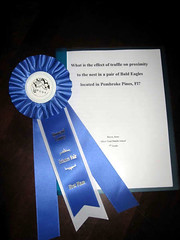 Jesus Hoyos, a 7th Grade Science student from Silver Trail Middle Jesus Hoyos, a 7th Grade Science student from Silver Trail Middle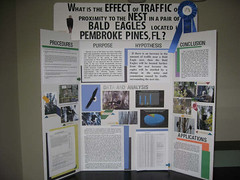 School, has won first place in his category (beating out over 50
other entries) in the Broward County Science Fair, and will move up to
the state competition in April. His project was a study of the "effect
of traffic on proximity to the nest in a pair of Bald Eagles located in
Pembroke Pines, Florida"
School, has won first place in his category (beating out over 50
other entries) in the Broward County Science Fair, and will move up to
the state competition in April. His project was a study of the "effect
of traffic on proximity to the nest in a pair of Bald Eagles located in
Pembroke Pines, Florida"
The Broward County Audubon Society also awarded a prize. Jesus will be
honored on March 24 at the Broward County Science Fair Awards Ceremony,
at New River Middle School in Fort Lauderdale.
His blue ribbon and exhibit are pictured here. Click on the
images for enlarged views. We wish Jesus Hoyos the best of luck in the
Florida State finals!
Should Eagle Nest Locations Be Disclosed?
Our local Bald Eagle nest has attracted much attention. On weekends,
there may be a dozen or more people watching the nest. Many are serious
birders and nature photographers. Others may have seen accounts in the
media, but an increasing number are casual passers-by who simply are
wondering why so many people are looking up into the trees. They stare
in amazement through spotting scopes and borrowed binoculars at the
breathtaking views of our living, breathing National Symbol. They
return with family members and neighbors. From other nest-watchers they
learn of the unique status of this pair of Bald Eagles, whose nest is
the first active one to be recorded in Broward County in nearly a half
century.
The Florida Natural Areas Inventory (FNAI), administered by Florida
State University, builds and maintains a comprehensive database of the
biological resources of Florida, using a ranking system developed by
The Nature Conservancy and the Natural Heritage Program Network. The
FNAI measures and evaluates the threats posed to each vulnerable
species, based on its status in Florida. The FNAI classifies the Bald
Eagle as "demonstrably secure" statewide, but vulnerable to extinction
in some restricted local areas of Florida.
The Florida FWC publishes the location of all active Bald Eagle nests
in the state. As a rule, specific information about the location of the
nests of rare
or threatened bird species should not be shared with unauthorized
individuals. Raptor nests are especially sensitive for several reasons.
Raptors have historically been persecuted in the belief that they
killed domestic livestock and poultry. Some early bird books classified
various species as "good" or "bad," and some hawks were often regarded
as belonging in the latter category because they killed chickens
and the "good" birds that ate insect pests.
In Alaska and parts of the northwest United States, Bald Eagles were
shot because fishermen accused them of causing a decrease in salmon. As
late as 1953, the Territory of Alaska paid a bounty of fifty cents to
two dollars for each pair of eagle feet, and bounty hunting became an
important part of the economy. Over 128,000 eagles were killed between
1917 and 1953, when the territorial legislature removed the bounty
after it found no evidence that the eagles contributed to the decline
of salmon. (Read more at http://www.sheldonmuseum.org/chilkatbaldeaglepreserve.htm)
Most raptors are large, and make attractive targets for shooters.
Before passage of Migratory Bird Treaty Act of 1918 and other
protective legislation, it was not uncommon for hawks to be gunned down
by the hundreds for "sport" along ridges during
migration. (See A Guide to the Laws and Treaties of the United States for Protecting Migratory Birds ). This practice continues in parts of Latin America.
Despite these laws and severe penalties, poachers still shoot hawks and
eagles. Although now most falconers use captive-bred birds, some still
may illegaly take the young of raptors. Publicizing the location of
raptor nests may encourage such illicit activities.
In the case of the Pembroke Pines eagles, was it bad for the media to publicly
disclose the nest site? Of course, the answer is unknown, as the birds
have not finished their nesting cycle. In fact, they are now entering a
critical period as the two eaglets gain strength and, within a couple
of weeks, will begin walking out on the branches of the nest tree. By
late March their parents will start bringing them less food, and even
make them scramble or make short flights to be fed. They will lose body
weight, making it easier for them to become airborne. Yet, if startled
by an unusual disturbance before they are ready to fly freely, they may
fall to the ground and face almost certain injury or death. In fact, up
to half of newly fledged eagles are said to perish within days of
leaving the nest.
A multitude of onlookers does create a disturbance. Research has shown
that other bird species show stress if humans stare directly at
them, rather than giving sideways glances, or if humans walk towards
them instead of approaching tangentially or indirectly. While these
experiments were done with prey species, and not predators like the
eagle, there is no reason to assume that eagles react any differently.
In fact, the visual acuity of eagles is about four times greater than
that of humans. We have seen both adults and chicks stare back
intently as we look at them through binoculars or photograph them.
Perhaps they are not expressing fear, but they are clearly aware of our
presence. Children may create a disturbance by running and playing
nearer to the nest while others are watching. Vehicles and
observers who stay inside vehicles, dress in somber colors, or move
about less seem to attract less attention.
The fact that the eagles nested successfully last year at the present
site, only 205 feet from the edge of busy Pines Boulevard,
indicates that the birds have developed a degree of tolerance for human
activities. Only last week, we observed an eagle roosting quiety in the
melaleuca snags to the west of the nest, while excavation with heavy
machinery was being carried out only about 100 feet away. Many times,
we noted that the sirens of emergency vehicles appeared not to change
their behavior. The study by the Middle School students attempts
to quantify the relationship between traffic density and proximity of
the eagles to the nest.
Potentially, public awareness of the active Bald Eagle nest may have
some positive effects. These magnificent birds, seen at such close
range, open a window to the natural world for all who stop to look.
Many were unaware of threats to the eagles, such as pesticides and
habitat loss, and of the laws that protect them. Greater public
knowledge and appreciation of the birds may lead citizens to support
actions by the local government to increase their protection.
Florida Department of Transportation should take measures to improve safety of observers at nest site
Pembroke
Pines Mayor Frank Ortis has appointed a Bald Eagle Sanctuary Steering
Committee to assist the City in developing a sanctuary on City land
that surrounds a recently-discovered Bald Eagle nest. This nest is the
first active eagle nest known to have been established in Broward
County since DDT was abolished in the 1970s. The existence of this nest
was publicized by local media, and has attracted much attention from
the general public. Since the nest is located only about 150 feet from
the edge of Pines Boulevard (State Highway 820), it may be readily
viewed from the grassy swale that borders the south shoulder of the
20800 block of the highway.
Earlier
this year, local officials as well as FDOT became aware of certain
hazards posed by the large number of observers who congregated along
the side of the roadway, especially during the months of January
through May, when young eagles were present in the nest. At various
times, especially on weekends, over 50 vehicles and more than 100
spectators gathered there at one time. Since most observers spent only
a limited time at the site, there was much turnover. Traffic and crowd
control measures were implemented. FDOT placed “No Parking”
signs along that stretch of roadway, in an attempt to eliminate the
collision hazard posed by vehicles stopping to park and re-enter the
highway. The City erected a fence around the property with “No
Trespassing” signs, and placed pylons along the entire block
about 30 feet from the roadway, to further discourage vehicular traffic
and keep pedestrians from approaching too close to the
nest.
In
an effort to educate the public and also to help maintain order during
times of peak visitor traffic, a cadre of local citizens assembled as
an ad hoc eagle watching group. Several of these lay citizens now serve
on the Mayor’s Steering Committee. At the July 20 meeting, they
related some experiences that raise very serious public safety and
liability concerns.
Unauthorized
parking continued even after the FDOT erected signs. This was often
innocent, as the signs faced the roadway rather than oncoming traffic.
Many drivers failed to see the signs until they were pointed out
by the volunteers or other observers. There were several “near
misses” due to vehicles slowing down (whether to park or inquire
about the reason for the presence of the crowds), but no collisions
were observed. Speeders and other drivers distracted by the
presence of the observers, or possibly by cell phones, sometimes veered
out of lanes and caused near-collisions. The lack of parking
spaces near the nest led some motorists to park in traffic lanes, such
as the westbound right and left turn lanes at 209th Avenue.
Most
seriously, pedestrians stood too close to the paved roadway. Looking at
the nest through binoculars and cameras, they sometimes backed up onto
the pavement. Small children were seen to actually venture into the
traffic lane while their parents were inattentive or distracted.
Thankfully, there have been no reports of pedestrian accidents, but
this situation creates an urgent and abiding concern to members of the
Steering Committee. We believe that the modest cost of providing safety
measures pales in comparison to the liability that may be associated
with a single serious injury or fatality.
Since
the eagles instinctively return to the same territory each winter to
begin the breeding cycle, and normally re-use the same nest, this
scenario, with its associated hazards, is be expected to be repeated in
future years. We believe that Florida Department of
Transportation has an interest in, and responsibility to assure the
safety of, pedestrians who view the eagle nest from FDOT property along
the south side of the 20800 block of Pines Boulevard. We request that
FDOT implement additional measures to reduce public liability for any
injuries or deaths that may result from failure to act before the
return of crowds of eagle observers in January, 2010.
We therefore suggest that FDOT traffic engineers evaluate and consider, in priority order:
1.
Place a temporary hard barrier along the south (eastbound) side of the
highway, to create a soft breakdown lane on the right shoulder, and
also to separate pedestrians from vehicular traffic. Since there are
several nest vantage points along the roadway, the barrier should be at
least 100 to 150 feet long. FDOT engineers could determine
construction, whether plastic water-filled, or concrete “Jersey
Barriers.” Observers would be limited to the south side of the
barrier, away from vehicular traffic.
2. Improve “No Parking” signage so that the signs face oncoming traffic.
3.
Add temporary warning traffic signs recommending that
motorists exercise caution and reduce speed along that stretch of
roadway during the months of January through May.
4.
Develop, in cooperation with the City of Pembroke Pines, durable
temporary signs that instruct pedestrian observers to utilize
crosswalks at signal lights (at corners of 209th and 208th
Avenues) and provide additional information to increase observer
safety, such as staying off the shoulder or roadway, controlling
children and pets, not littering, (etc).
5.
Consider construction of a pedestrian sidewalk on the south side of the
block, in view of the increased pedestrian traffic at all times of the
year (due not only to the eagle nest, but also the new High School and
the recently-installed traffic signals at 209th Avenue that provide
additional protected access to the bus stop at the SE corner of
208th Avenue).
6.
While parking concerns are mainly within the purview of local
authorities, FDOT may be offer some advice and assistance to the City.
Pembroke Pines Mayor Frank Ortis Appoints Eagle Sanctuary Steering Committee
STATEMENT OF GOALS (Adopted July 20, 2009)
The City of Pembroke Pines Bald Eagle Sanctuary Steering Committee will recommend
measures to:
- Protect and preserve Bald Eagle nesting sites in the City of Pembroke Pines.
- Promote public knowledge and appreciation of local Bald Eagles
- Provide opportunities for the public to safely observe the Bald Eagle nest
OBJECTIVES
The Bald Eagle Steering Committee will:
- Work with City administration to develop appropriate legal instruments establishing a Pembroke Pines Bald Eagle Sanctuary
- Assist City of Pembroke Pines in enacting an ordinance to protect Bald Eagle nesting sites within the City
- Identify, prioritize and recommend actions to control public access and provide safe parking for observers
- Explore alternatives and develop specifications for a viewing area during nesting season
- Develop
plans and seek funding from other governmental and private sources
forsanctuary-related construction, public education and research
Minutes and documents from the Steering Committee meetings and activities may be viewed on the Eagle Nest Watching page.
The Steering Committee presented a Position Paper to Florida Department of Transportation concerning safety of observers at nest site.
The FDOT Response
to the Steering Committee's safety concerns, while not entirely
unexpected, was disappointing. While the agency took measures to assure
that cars do not park illegally off the roadway in front of the nest,
they also prohibited parking along the entire length of the highway on
that side.
Further, FDOT could not honor the Steering
Committee's request that FDOT place soft barriers, such as orange
barrels with plastic mesh fencing, along the shoulder to help separate
viewers from vehicular traffic. They cited concerns of traffic
engineers about limited sight distance and collision avoidance space,
although this is a very straight stretch of roadway. Effectively,
pedestrians are barred from standing on that side of the street.
This
leaves only the sidewalk across the street available for
observers. As the eaglets become more visible
and active during the months of February through May, we
expect to again experience large numbers of viewers, especially on
weekends. Seeing no place to park, (although there is a Post Office parking lot only about 1000 feet away)
they will create an enforcement problem for local police by stopping in
traffic lanes and parking in the turn lanes. FDOT did provide a glimmer
of hope that a new sidewalk in front of the nest, which is planned for
completion in 2011, might provide a viewing platform.
Pembroke Pines City Commission Initiates Action to Formally Protect the Eagle Nest
The
conservation policies to protect the eagles and pave the way for an
Eagle Protection Ordinance were passed by the Pembroke Pines City
Commission on first reading and were reviewed favorably by the Florida
Department of Community Affairs. The second reading and adoption
is scheduled for 9/21/10.
From the City of Pembroke Pines Web site:
SUMMARY EXPLANATION AND BACKGROUND (Supporting documents for Agenda of August 18, 2010 City Commission meeting):
1. At the 4/21/2010 City Commission meeting, The Commission
requested staff to prepare an information packet in their motion to pass
Proposed Ordinance No. 2010-10 on first reading (2010-10 is now
bifurcated into 2010-16ARA and 2010-17ARB Comprehensive Plan text
amendments on this evening's agenda).
2. In the spring of 2008, a bald eagle nest was discovered on the
City's Chambers plat property on the south side of Pines Boulevard, west
of 208th Avenue.
3. In response to concerns of residents to protect the eagles as
well as the residents who wanted to view the eagles and eaglets, the
Bald Eagle Sanctuary Steering Committee was formed. The Steering
Committee recommended the creation of an eagle protection ordinance
based on many of the guidelines of the FWC management plan (see Exhibit
2).
4. The proposed policies in the Conservation Element (Proposed
Ordinance No. 2010-17ARB) are recommended by the Bald Eagle Sanctuary
Steering Committee and provide the foundation for the creation of an
eagle protection ordinance (see exhibit 3). An update to Objective IV
and the addition of Policies 4.24 though 4.27(highlighted in Exhibit 3)
address this issue.
5. Attached for your information is an executive summary prepared
by the Bald Eagle Sanctuary Steering Committee, and the Florida Fish
and Wildlife Commission Bald Eagle management plan.
6. Staff will present to Commission drafts of the proposed ordinance in the near future.
= = = = =
The entire document may be viewed at this link on the main Eagle Watch web page. Here are pertinent excerpts from the Comprehensive Plan:
Proposed Policies 1.4 and 4.27 have been added pursuant to House Bill 697 and are
consistent with the Broward County Conservation Element's adopted policies. In addition,
the City is proposing to modify Objective IV and add policies 4.24 through 4.26 providing
for the preservation and protection of the city's Bald Eagle active Bald Eagle nest. Tables
CE-1 and 2 have also been updated.
In 2007, the City's first active Bald Eagle nest was identified and Proposed Policies 4.24
through 4.26 have been added to protect and preserve the nest as well as a provide the
foundation for the adoption of an eagle sanctuary protection ordinance.
OBJECTIVE IV
Conserve, protect, maintain or improve native vegetative communities, wildlife
habitats, wetlands, Bald Eagle nesting sites, and marine habitats through 2015 in
accordance with Broward County and City of Pembroke Pines standards.
Policy 4.24 - The City shall protect and preserve Bald Eagle nesting sites and
promote educational programs for the residents by establishing a Pembroke Pines
Bald Eagle Sanctuary Protection ordinance to be adopted no later than September
2011.
Policy 4.25 - Identify, prioritize, and recommend alternative actions to control public
access and coordinate with federal, state, regional, county and local agencies to
explore safe parking options and viewing areas during nesting season.
Policy 4.26 - Continue to coordinate with the Eagle Sanctuary Steering Committee
in the development of plans and in the identification of funding sources for
sanctuary activities including the installation of a web cam, public education
programs, signage, and research.
|
|
